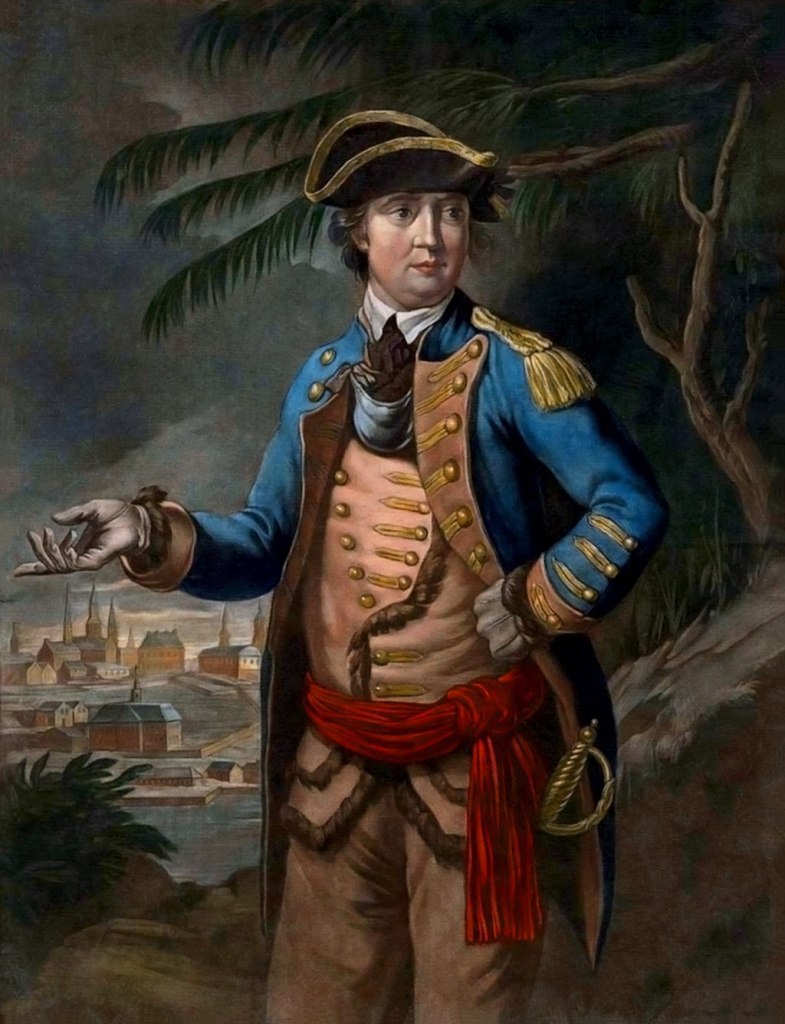It was 245 years ago this month that, shortly after the start of the Revolutionary War, a bold declaration of American liberty rang out.
No, it was not the Declaration of Independence, which came from Philadelphia in in July 1776 and became a widely celebrated national holiday. This earlier, largely-forgotten declaration came from northern New York along the shores of Lake Champlain.
On June 15, 1775, not far from what is now Crown Point State Historic Site, 31 men from the Northeast signed a so-called “Declaration of Principles,” vowing they would “never become slaves,” calling for a “union” of the states, and giving their allegiance to the newly formed Continental Congress in Philadelphia.
Among those who publicly embraced armed resistance to the British Crown in the name of a new government was the document’s author, a man who went from one of the Revolution’s earliest battlefield heroes to its most despised traitor five years later.
That man was Benedict Arnold (1740-1801), and the path to his infamous treason in New York stretches from that now largely forgotten declaration, issued from the state’s northern frontier in what is now Essex County, to an infamous meeting with a spy along the shores the Hudson River— now within Rockland Lake State Park—where he agreed to betray the Revolution and deliver the river’s critical West Point fortress to the British.
In the five years between those two events, Arnold distinguished himself by buying the Revolution a critical year at the naval Battle of Valcour Island on Lake Champlain in 1776. The following year, he contributed to the relief of Fort Stanwix after the Battle of Oriskany in the Mohawk Valley and was instrumental in the decisive American victory at Saratoga.
His earlier role in capturing Fort Ticonderoga in May 1775 to the south of Crown Point had provided Patriot forces with desperately needed heavy cannon that later helped drive British troops out of Boston. That victory set the stage a month later for Arnold, as commander at Ticonderoga, to issue written principles from Crown Point to rally support for the Patriot cause.
At the time, Arnold and the other men who signed the declaration did so at great personal risk, as it targeted them personally as potential traitors to Great Britain when the punishment for treason was death.
Flush from success at Ticonderoga, here is what Arnold wrote and he and other prominent early supporters, who came from New York, Connecticut, Massachusetts and what later become Vermont, signed.
Benedict Arnold’s Declaration of Principles
Crown Point, 15th June, 1775
Persuaded, that the Salvation of the Rights and Liberties of America, depends, Under GOD, on the firm Union of its Inhabitants, in a Vigorous Prosecution of the Measures necessary for its Safety And Convinced of the Necessity of preventing the Anarchy and Confusion which attend a Dissolution of the Powers of Government, WE, the Freeman, Freeholders, and Inhabitants of the Province of New York, being greatly alarmed at the avowed Design of the Ministry to raise a Revenue in America; and, Shocked by the bloody Scene now Acting in the Massachusetts Bay, DO, in the most Solemn Manner Resolve never to become Slaves; and do Associate under all the Ties of Religion, Honour, and Love to our Country, to Adopt and endeavour to Carry into Execution whatever Measures may be Recommended by the Continental Congress; or Resolved Upon by our Provincial Convintion for the purpose of preserving our Constitution and opposing the Execution of the Several Arbitrary and oppressive Acts of the British Parliament; Untill a Reconciliation Between Great Britain and America, on Constitutional Principles Which we most Ardently Desire Can be obtained And that we will in all Things follow the Advice of our General Committee Respecting the purposes aforesaid, The Preservation of Peace and Good Order, and the Safety of Individuals, and private party.
Click on this slideshow of images from the Crown Point State Historic Site, near where the Declaration of Principles was issued 245 years ago shortly after the start of the Revolutionary War.
Arnold’s words may have been largely forgotten, but his ultimate fate remains relatively well known. As the war went on, he felt slighted and upset from being passed over for promotion, with other officers getting credit for his accomplishments. Arnold could be brusque and headstrong, which alienated some. He borrowed heavily to support a lavish lifestyle.
And while military governor of Philadelphia, Arnold married a woman named Peggy Shippen, who came from a prominent city family loyal to British King George III. His new wife introduced him to one of her former suitors _ the British spy Major John Andre.
Arnold had been given command of West Point by George Washington, on the advice of his trusted advisors, Albany resident and General Philip Schuyler and Robert Livington of the Hudson Valley . (The residences of both men are now state Historic Sites.)
Once his plot with Andre to surrender West Point was found out, Arnold fled to the safety of British lines, where he was made an officer and fought against his former comrades. After the war, he lived in Canada and England, before dying in London in 1801 at age 60.


Use this map to locate Crown Point and the other historic places in New York State described in this story.
Signatories of the Crown Point declaration had a variety of fates. One of its most prominent signers, William Gilliland, was an Irish immigrant and New York City merchant who was the first European to settle the lands west of Lake Champlain. He was founder of the town of Willsboro, and at one point, controlled about 50,000 acres in the region between Crown Point and Plattsburgh, leasing some of it out to tenant farmers and developing gristmills and sawmills.
In spite of Gilliland’s wealth and influence, as well as his signing of the Crown Point declaration and his financing of Patriot militia, he was mistrusted because of “unfounded allegations relative to his loyalties,” likely due to disagreements and entanglements involving Arnold and Ethan Allen, commander of the Green Mountain Boys, a militia from Vermont, as recounted in documentary sources.
With both sides suspecting that he was secretly supporting the other, Gilliland was confined to Albany during part of the war. The aftermath destroyed Gilliland’s vast fortunes, stripped him of his lands and left him destitute by the time he died in Willsboro in 1796 at age 62. He is buried in the town that still bears his name.

But most other signers of the Crown Point declaration fared better. Among them was Dirck Swart, a Dutchess County native and a member of the Albany Committee of Correspondence from Saratoga, according to information collected by the Fort Ticonderoga Museum.
These committees were shadow governments organized by Patriot leaders on the eve of the Revolution. They shared plans for strategy and by the early 1770s they wielded considerable political power.
Swart owned a tavern in Stillwater, Saratoga county, and his home still stands in the village. The residence was built in 1757 and remains among the oldest extant dwellings in Saratoga County. It was from Swart’s home that Arnold began his 1777 march to relieve Patriot forces at Fort Stanwix.
After the war, he was the town’s first postmaster, served as the Saratoga County Clerk, and was elected to the state Assembly. In 1788, he was a delegate to the state convention to accept the new U.S. Constitution.
At age 70 in 1804, Swart died a venerable and respected citizen, having prospered in the new country that he had helped launch by signing that bold statement from Crown Point.

Cover Photo: Crown Point State Historic Site (Photo Credit- NYS Parks) All photos NYS Parks unless otherwise noted.
By Brian Nearing, Deputy Public Information Officer for New York State Parks
Signers of the Crown Point Declaration of Principles by State
New York
- Benedict Arnold
- John Corbin
- Zadok Everest
- Joseph Franklin
- William Gilliland
- Charles Graham Jr.
- Ebenezer Hyde
- Benjamin Kellogg
- Robert Lewis
- Moses Martin
- Ebenezer Marvin
- Martin Marvin
- Daniel McIntosh
- Elisha Painter
- George Palmer
- William Satterlee
- Thomas Sparham
- Dirck Swart
- Thomas Weywood
- Hugh Whyte
Massachusetts
- Jonathan Brown
- Ezra Buell
- James Noble
Connecticut
- John Watson Jr.
- Samuel Keep
Vermont (this state was created a year after the Crown Point Declaration)
- John Grant
- Issac Hitchcock
- Robert Lewis
- David Vallance
- Samuel Wright
State Unclear
- Francis Moor
- James Wills
Source: Fort Ticonderoga Musuem







The author of this piece did a good job (critique based on two-plus decades of in-depth research, interpretation & presentation to tens of thousands members of the public (international as well as Americans). Arnold’s role at Crown Point & in the Champlain Valley was a ‘fact’ I uncovered early in my career and espoused during all those years (q.v. Clare Brandt’s book, “The Man In the Mirror” among other sources). Curious why this is “source(d): Fort Ticonderoga Museum”?
Thanks for your review. The listing of the signatories was provided State Parks for our use by the Fort Ticonderoga Museum, so appropriate credit was given. It sounds like you have delved very deeply into the story of this enigmatic figure. Given the nature of weekly deadlines here, our research time was more limited. Thanks again for reading the NYS Parks blog…
Let’s say that many will tell you that I know more about the ‘story’ of Crown Point after spending more than two decades at the Site as its primary researcher, interpreter and educator. This is not bragging, but statement of fact as I dedicated almost every waking hour to the Site and its promotion. As they say, we must learn from history. Also, thank you for explaining crediting Fort Ticonderoga, but it would have been much easier to refer to the “American Archives” where documents of this sort have been published.